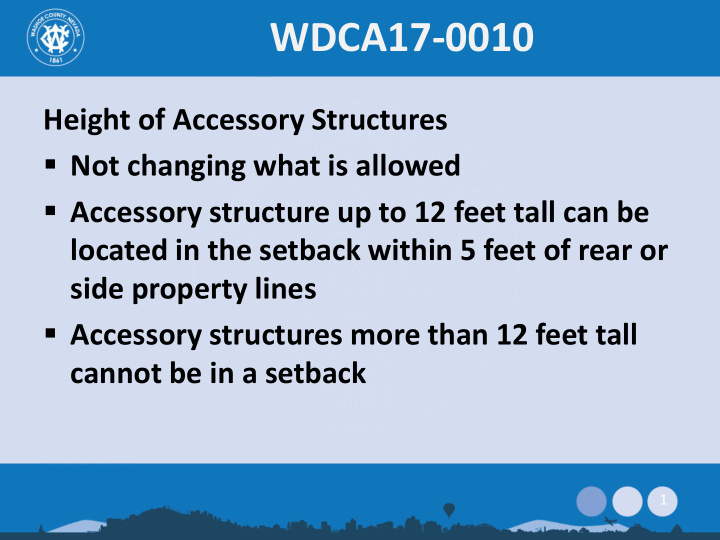



WDCA17-0010 Height of Accessory Structures Not changing what is allowed Accessory structure up to 12 feet tall can be located in the setback within 5 feet of rear or side property lines Accessory structures more than 12 feet tall cannot be in a setback 1
WDCA17-0010 Accessory Structures Only applies to Accessory Structures Make clear that structures in the setback cannot be more than 12 feet tall Height of a building is measured to average height (mid point) of highest roof 2
How building height is determined Article 902 Definitions Definition is not changing All structures that conform to the required setbacks will still use this definition to determine building height 3
Buildings in setbacks Problem – if 902 definition applies to structures built in the setback and finished grade within 5 feet of structure is less than 10 feet, the structure can be significantly taller than 12 feet. Example – If ground surface on one side of building is 6 feet above other side of building, the building in the set back is now 20 feet tall. (12 feet tall, plus 6 feet grade difference) Result – impacts neighbor who now has a 20 foot tall building five feet from his property line. 4
Proposed Code Change Section 110.306.10 Detached Accessory Structures. Detached accessory structures are defined in Article 304, Use Classification System, under Section 110.304.15, Residential Use Types. The following development requirements shall apply to detached accessory structures: (b) Setbacks. (1) Accessory structures 12 feet in height or less may be located within the required rear and side yard setbacks provided they are five feet or more from the rear and side property line. The height of an accessory structure located within the required rear or side yard setback as provided in this subsection shall be measured from the lowest finished grade of the structure to the average height of the highest gable of a pitched or hipped roof. Except as otherwise specifically provided, all accessory structures are prohibited within the required front yard setback. (2) Accessory structures more than 12 feet in height shall comply with the yard setbacks for the main dwelling units stipulated in Article 406, Building Placement Standards. Except as otherwise specifically provided, no accessory structure shall exceed 35 feet in height. (c) Height Limits. The height of an accessory structure located outside of all required setbacks shall be measured in accordance with the building height provision in Article 902 of this code.. 5
Proposed Code Change Structures built in the setback shall be measured from finished grade to mid peak – Maximum allow height of 12 feet. Building that conform to setback are still allowed to be up to 35 feet in height Code amendment does not change how building height is determined when a structure outside of the required setback. 6
Motion - Initiation I move that, after giving reasoned consideration to the information contained in the staff report and received during the public hearing, the Washoe County Planning Commission initiate the amendment to Washoe County Code Chapter 110 within Article 306, Accessory Structures and Uses, as described in the staff report for WDCA17-0010. 7
Motion - Amendment I move that, after giving reasoned consideration to the information contained in the staff report and received during the public hearing, the Washoe County Planning Commission recommend approval of WDCA17- 0010, to amend Washoe County Code Chapter 110 within Article 306, Accessory Uses and Structures , as described in the staff report for this matter. I further move to authorize the Chair to sign the resolution contained in Attachment A on behalf of the Planning Commission and to direct staff to present a report of this Commission’s recommendation to the Washoe County Board of County Commissioners within 60 days of today’s date. This recommendation for approval is based on all of the following four findings in accordance with Washoe County Code Section 110.818.15(e): 1. Consistency with Master Plan; 2. Promotes the Purpose of the Development Code; 3. Response to Changed Conditions; and, 4. No Adverse Affects. 8
Recommend
More recommend